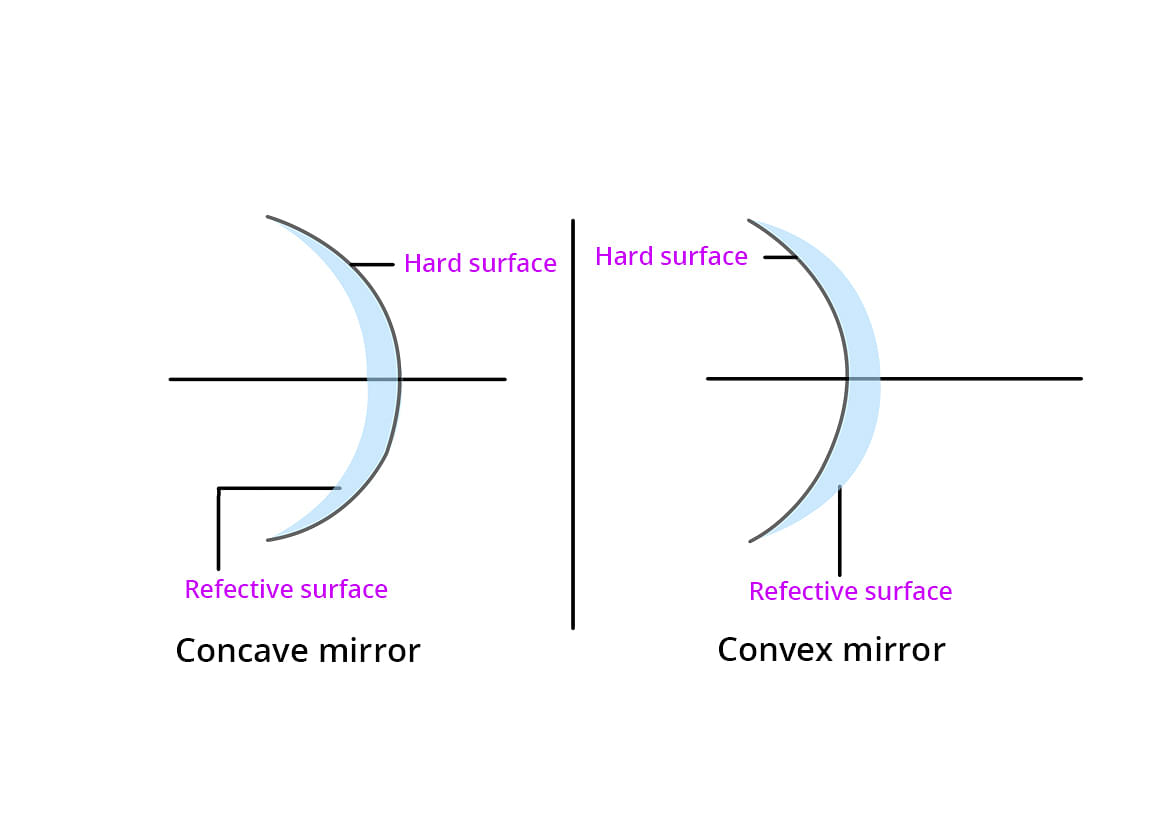Question:
If in the following figure, height of object is $H_{1}=+2.5 \,cm$, then height of image $H_{2}$ formed is Concave mirror
If in the following figure, height of object is $H_{1}=+2.5 \,cm$, then height of image $H_{2}$ formed is Concave mirror
Updated On: Sep 25, 2024
- -5 cm
- +5 cm
- +7.5 cm
- -7.5 cm
Hide Solution
Verified By Collegedunia
The Correct Option is A
Solution and Explanation
Magnification is ratio of size of image to that of object.
Here, $u=-1.5 \,\,f, f=-f$
From concave mirror formula,
$\frac{1}{f}=\frac{1}{v}+\frac{1}{u}$ we have,
$\frac{1}{(-f)}=\frac{1}{v}+\frac{1}{(-1.5 f)}$
$\therefore \frac{1}{v}=-\frac{1}{v}+\frac{1}{(-1.5 f)}$
$\therefore \frac{1}{v}=-\frac{1}{3 f}$ Or $v=-3 f$
Now, magnification in mirror is given by
$m=\frac{I}{O}=\frac{v}{-u}$
where $I$ is size of image,
and $O$ is size of object.
Here, $0=+2.5 \,cm$
$\therefore \frac{I}{2.5}=\frac{-3 f}{-(-1.5 f)}$
$\therefore I=-5 \,cm$
Note: In case of a concave mirror, magnification may be positive or negative, but in case of convex mirror magnification is positive only.
Here, $u=-1.5 \,\,f, f=-f$
From concave mirror formula,
$\frac{1}{f}=\frac{1}{v}+\frac{1}{u}$ we have,
$\frac{1}{(-f)}=\frac{1}{v}+\frac{1}{(-1.5 f)}$
$\therefore \frac{1}{v}=-\frac{1}{v}+\frac{1}{(-1.5 f)}$
$\therefore \frac{1}{v}=-\frac{1}{3 f}$ Or $v=-3 f$
Now, magnification in mirror is given by
$m=\frac{I}{O}=\frac{v}{-u}$
where $I$ is size of image,
and $O$ is size of object.
Here, $0=+2.5 \,cm$
$\therefore \frac{I}{2.5}=\frac{-3 f}{-(-1.5 f)}$
$\therefore I=-5 \,cm$
Note: In case of a concave mirror, magnification may be positive or negative, but in case of convex mirror magnification is positive only.
Was this answer helpful?
1
3
Top Questions on Spherical Mirrors
- Distance between twice-magnified virtual image of an object placed in front of mirror is 15 cm. Find focal length of spherical mirror in cm.
- JEE Main - 2024
- Physics
- Spherical Mirrors
- Distance between virtual image, which is twice the size of object placed in front of mirror and object is 45 cm. The magnitude of focal length of the mirror is _____cm.
- JEE Main - 2024
- Physics
- Spherical Mirrors
- A convex lens of focal length $20\, cm$ is placed in front of convex mirror with principal axis coinciding each other The distance between the lens and mirror is $10\, cm$ A point object is placed on principal axis at a distance of $60 \, cm$ from the convex lens The image formed by combination coincides the object itself The focal length of the convex mirror is ________ $cm$
- JEE Main - 2023
- Physics
- Spherical Mirrors
- The radius of curvature of a spherical mirror is 16 cm. What is the focal length ?
- TS POLYCET - 2023
- Physics
- Spherical Mirrors
- When the object lies at infinite distance in front of concave mirror then the nature of the image is
- WBJEE JENPAS UG - 2023
- Physical Sciences
- Spherical Mirrors
View More Questions
Questions Asked in DUET exam
- A hammer of mass $200\, kg$ strikes a steel block of mass $200\, g$ with a velocity $8\, ms^{-1}$. If $23\%$ of the energy is utilized to heat the steel block, the rise in temperature of the block is (specific heat capacity of steel = $460 \; J \; kg^{-1} \; K^{-1}$)
- DUET - 2019
- specific heat capacity
- What is the shape and magnetic nature of permanganate ion ?
- DUET - 2019
- d -and f -Block Elements
- The mobility of charge carriers increases with
- DUET - 2011
- Electric Current
- Phagocytosis and pinocytosis are collectively termed as
- DUET - 2011
- Cell: the unit of life
- How many $ 1\,\mu F $ capacitors must be connected in parallel to store a charge of $1\, C$ with a potential of $110\, V$ across the capacitors?
- DUET - 2011
- electrostatic potential and capacitance
View More Questions
Concepts Used:
Spherical Mirrors
A spherical mirror is a mirror which has been cut out of a spherical surface.
There are two kinds of spherical mirrors:
- Convex Mirror
- Concave Mirror

Concave Mirror
Concave mirrors are also called converging mirrors, because in these types of mirrors, light rays converge at a point after impact and reflect back from the reflective surface of the mirror.
Convex Mirror
The convex mirror has a reflective surface that is curved outward. Regardless of the distance between the subject and the mirrors, these mirrors are "always" virtual, upright and reduced.



